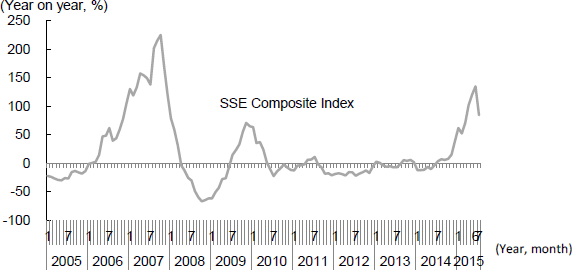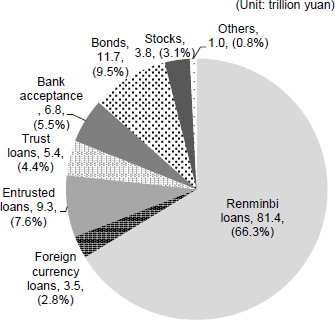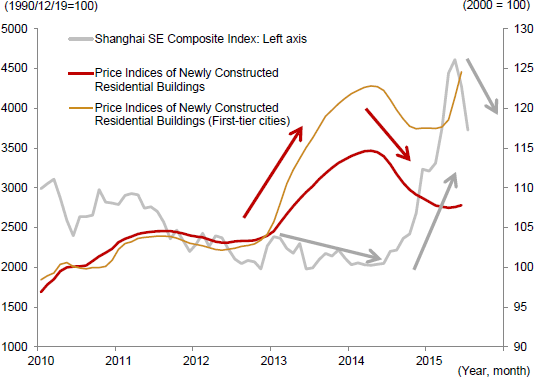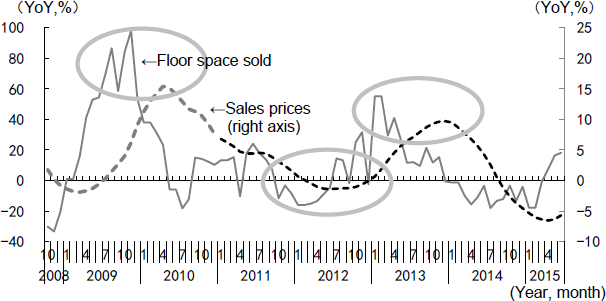There are mounting concerns in China that the economy will weaken further, with consumption and investment falling, reflecting the collapse of stock prices since mid-June 2015. However, if funds leaving the stock market flow into the housing market, which has already shown signs of recovery, a further slowdown in the economy can probably be avoided.
The impact of the collapse in stock prices on consumption and investment is limited
Even though stock prices have collapsed in China, as of July 2015, the Shanghai Stock Exchange Composite Index is still 80% higher than its level a year ago. This suggests that there are still far more winners than losers among investors in the stock market. Accordingly, even after the sharp fall in stock prices, the asset effect of changes in stock prices on consumption has remained positive although its margin has shrunk (Figure 1).

There is also concern that the suspension of the initial public offering (IPO) implemented as part of the measures to support stock prices will reduce investments. However, given that the financing of companies with stocks accounts for only 3.1% of total social financing (based on the balance at the end of 2014), the impact should be limited (Figure 2). Borrowings from banks are still the largest source of funding for companies (accounting for 66.3% of total social financing), and financing costs have declined somewhat due to a series of rate cuts.

Spillovers on the housing market worth noting
Meanwhile, in contrast to other countries, there is a negative--rather than positive--correlation between stock prices and housing prices in China (Figure 3). This may reflect the large-scale movement of funds between these two markets in an environment where alternative investment opportunities are limited.

In fact, from 2013 to 2014, as housing prices rose sharply, stock prices were depressed, while in the second half of 2014, when housing prices entered a correction phase, stock prices began rising sharply. Around the middle of 2015, as housing prices moved upward again, stock prices collapsed.
When thinking about the impact on the macro economy, changes in housing prices are more important than fluctuations in stock prices. Whether or not the negative correlation between housing prices and stock prices will continue is of particular importance.
Since the second half of 2014, the Chinese economy has been slowing, and the real gross domestic product (GDP) growth rate fell from 7.4% on a year-on-year basis in the first half of 2014 to 7.0% in the first half of 2015 despite rising stock prices, due largely to the downturn in the housing market. In 2014, real estate-related investments (in nominal terms) amounted to 9.5 trillion yuan, or 14.9% of GDP (of which housing-related investments was 6.4 trillion yen, or 10.1% of GDP). With stagnant housing prices as a backdrop, year-on-year growth in investment in real estate development declined from 14.1% in the first half of 2014 to 4.6% in the first half of 2015. This alone should have dragged down the GDP growth rate by about 1.4 percentage points (14.9% × [14.1% - 4.6%] = 1.42%).
Given the previous trend for housing prices to start to move six months to a year after the floor space of residential buildings sold (both measured on a year-on-year basis), we could argue that the latter is an effective leading indicator of the former (Figure 4). In fact, year-on-year growth in the floor space of residential buildings sold has already turned positive since April 2015, suggesting that housing prices will head toward recovery before long. If funds flow from the stock market to the housing market, it is expected that housing prices and, in turn, investment in real estate development will also pick up. In that case, China will maintain an economic growth rate of around 7.0% in the latter half of 2015 as well as in 2016.



